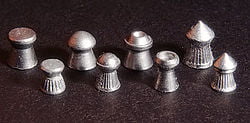Airgun Pellets
Pellets are non-spherical projectiles designed to be fired from an airgun. Air gun pellets differ from bullets used in firearms because of the pressures encountered: airguns operate at pressures as low as 50 atmospheres, while firearms operate at thousands of atmospheres. Airguns generally use a slightly undersized projectile that is designed to obturate upon shooting so as to seal the bore, and engage the rifling; firearms have sufficient pressure to force a slightly oversized bullet to fit the bore in order to form a tight seal. Since pellets may be shot through a smoothbore barrel, they are often designed to be inherently stable, much like the Foster slugs used in smoothbore shotguns.
The “diabolo” (or “wasp waist pellet”) is the most common design found today. It can have a flat, round, hollow or pointed tip, followed by a taper to a thin waist. From the waist back, the pellet is hollow, and flares out to full diameter when pressurized by the gun. The head, or solid part in front of the waist, is usually sized to fit the bore just touching the rifling. This keeps the pellet centred in the bore, while keeping the friction as low as possible. The effect of friction is used in order to keep the pellet stationary until the piston has reached the end of its travel, compressing as much air as is inherently possible. The skirt of the pellet is thin, and made of a malleable material, usually lead, although non-toxic alternatives are available that use tin or even plastic. When shot, the skirt will obturate to fit the bore and provide a good seal, and engage the rifling, whereby imparting spin. In a smoothbore barrel, the skirt will still flare to provide a tight seal, but since there is no rifling, the pellet will not spin, and is less accurate. In most cases of this type, the solid head in the front and hollow skirt in back will work to prevent the pellet from tumbling. However, this is not always the case, and some ammo types of this nature will tumble in flight, and hit the target sideways. When this happens the pellet will not leave a clean, round hole in the paper, but will instead, leave behind a keyhole-shaped silhouette. This phenomenon is known as keyholing.
Most airgun pellets are designed to travel at subsonic speeds. High velocities can cause light pellets to overly deform, or even break apart in flight. The transition from subsonic to supersonic velocities will cause almost all pellets to tumble. The closer a pellet gets to the speed of sound, the more unstable it becomes. This is a problem for high powered break-barrel and pre-charged pneumatic air rifles, which often can push a normal pellet to velocities exceeding the speed of sound. A few companies have addressed this issue by manufacturing heavier than normal pellets for use in these high powered air guns. The heavier weight of these pellets ensure that they will travel at speeds well below the sound barrier, resulting in less tumbling and more overall accuracy. Their weight also makes them less susceptible to air resistance, and thus imparts more kinetic energy downrange, increasing lethality.
Text is available under the Creative Commons Attribution-ShareAlike License
You Can Check Out Premium Airgun Pellets HERE
You Can Check Out Airgun Hunting Pellets HERE
Some of Our favorite brands of airgun pellets:
Crosman Pellets On Amazon
Daisy Pellets On Amazon
JSB Pellets On Amazon
H&N Pellets On Amazon
Gammo Pellets On Amazon
H&N Excite Pellets On Amazon
RWS Pellets On Amazon
*I get commissions for purchases made through links in this post.

Recent Post Comments